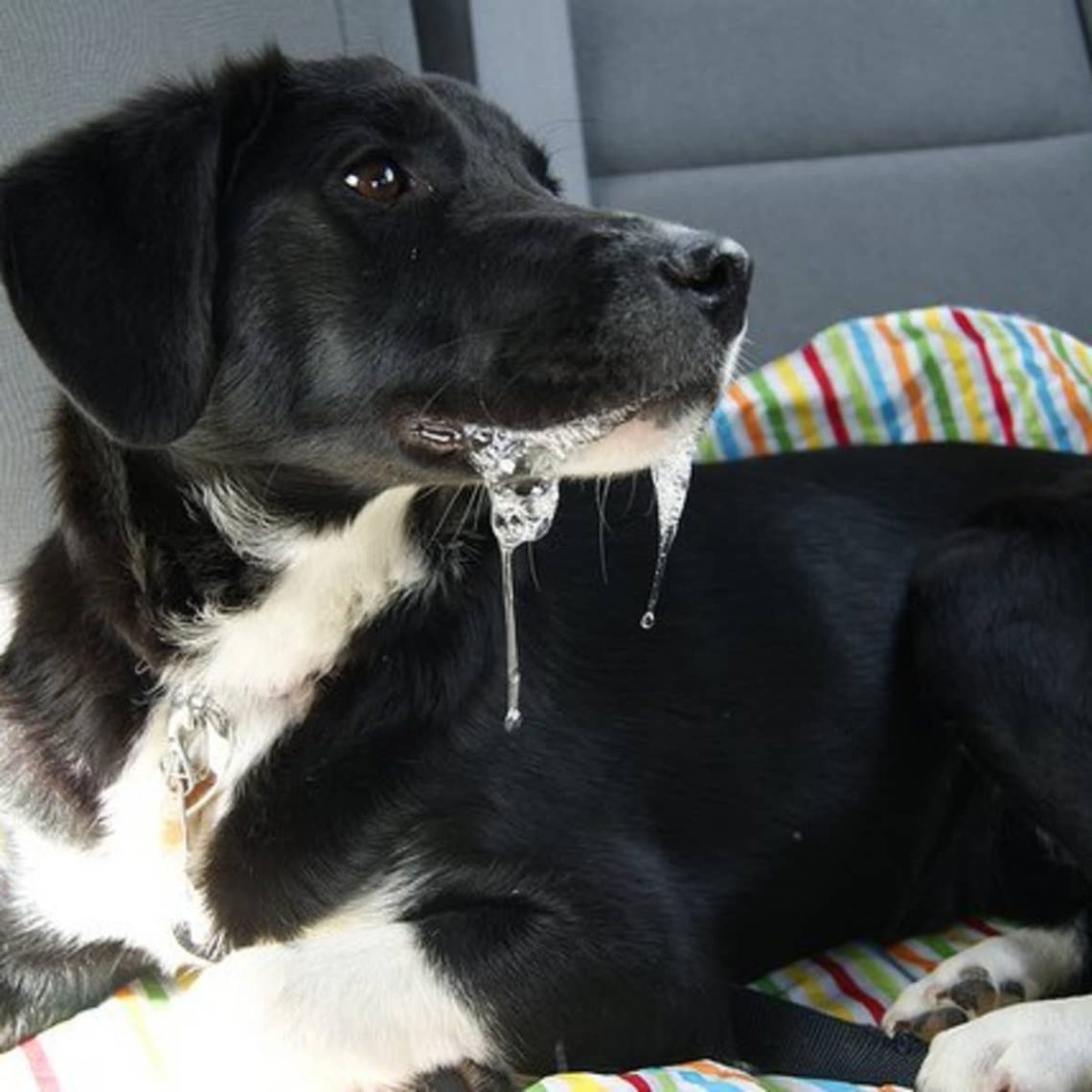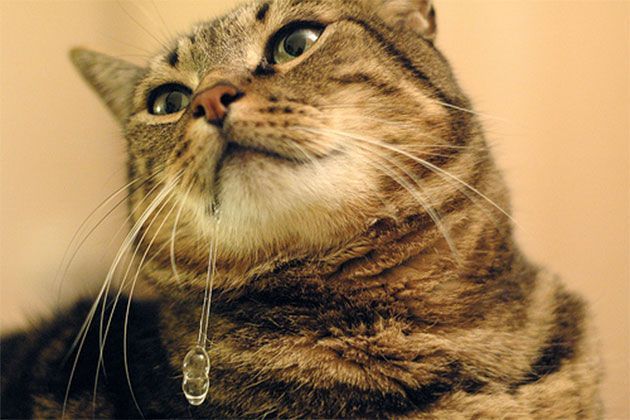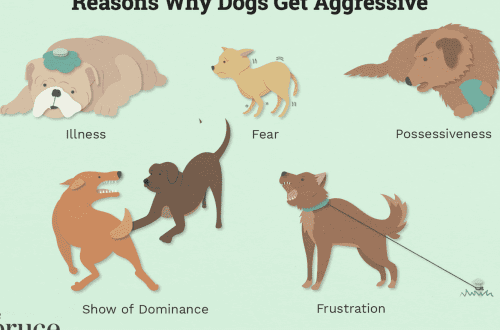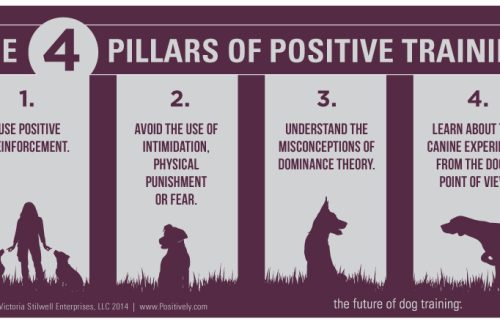
Excessive salivation in dogs and cats

Why can a pet salivate? Consider the causes of excessive salivation in cats and dogs.
Hypersalivation, also called ptyalism and sialorrhea, is an excessive secretion of saliva with hyperfunction of the salivary glands located in the oral cavity. Saliva has a lot of functions: purification and disinfection, softening of solid pieces of food, primary digestion due to enzymes, thermoregulation and many others.
Contents
Normal salivation in animals
Saliva is normally produced in different situations. This process is regulated by the central nervous system. There is a false hypersalivation, when it seems to the owner that there is too much saliva, but this is not so. This is mainly faced by the owners of St. Bernards, Newfoundlands, Cane Corso, Great Danes, Mastiffs, and other dogs with drooping wings, while when the dog shakes off, saliva scatters all over.
Physiological secretion of saliva
- Eating.
- Reflex salivation. Everyone knows the story about Pavlov’s dog, which secreted saliva and gastric juice, when the professor turned on the light bulb – the animal at the reflex level associated light with an early intake of food. So in our pets, the expectation and anticipation of receiving food can cause increased salivation.
- Reaction to appetizing smell.
- Increased salivation when something bitter enters the oral cavity, for example, when giving medicines. Cats often have such a reaction when forcibly introducing any drug or food.
- Physical activity, such as running or participating in competitions.
- Overexcitation, such as when a male smells a bitch in heat. In this case, there is excessive salivation and trembling of the jaw, as well as the specific behavior of the male.
- Nervous tension. Especially often noticeable at the doctor’s appointment is salivation in cats that experience severe fear and stress.
- The opposite feeling, for example, when showing tender feelings for the owner, when receiving pleasure, for example, when stroking, occurs in both dogs and cats, there may also be clear discharge from the nose.
- Relaxation. It is not uncommon to see a puddle of saliva under the cheek of a sweetly sleeping dog.
- Motion sickness in vehicles. From motion sickness, for example, you can use Serenia.
When salivation is a pathology
Pathological hypersalivation can be caused by many reasons:
- Mechanical injuries and foreign objects in the oral cavity. In dogs, injuries are often caused by stick chips, and in cats, a sewing needle or toothpick can often get stuck. Be careful not to leave dangerous items unattended.
- Chemical burns. For example, when biting off flowers or accessing household chemicals.
- Electrical injury.
- Vomiting of various etiologies.
- Diseases and foreign objects in the gastrointestinal tract. May be accompanied by nausea and vomiting. However, one of the first signs of nausea is hypersalivation.
- Poisoning. Additional symptoms may include apathy and incoordination.
- Uremic syndrome in chronic renal failure. Ulcers form in the mouth.
- Salivation and vomiting in acute intoxication. For example, in acute urinary retention, rapid kidney damage occurs, protein metabolism products enter the blood in large quantities, causing the animal to feel unwell.
- Dental problems and oral diseases. Inflammation of the gums, fractures of the teeth, tartar, caries.
- Damage to the salivary glands: inflammation, neoplasms, cysts
- Acute viral diseases, for example, feline calicivirus. There is also acute pain, ulcers in the oral cavity, increased salivation, decreased appetite.
- Rabies, tetanus. Deadly diseases, including for humans.
- Dislocation or fracture of the jaw. In this condition, the mouth does not close and saliva can flow out.
- Traumatic brain injury. With a fall or a strong blow, with a bruise of the brain, you can also encounter ptyalism.
- Heatstroke. Usually this reason is easy to establish, since the animal was either in direct sunlight or in a stuffy enclosed space.
Diagnostics
For diagnosis, it is most important to take a thorough history: age, gender, vaccination status, contact with other animals, access to drugs, household chemicals, chronic or acute diseases, and much more. Try to collect your thoughts and tell the doctor reliable and complete information. If the cause of salivation is not obvious, then the doctor will conduct a thorough examination, especially focusing on the oral cavity. If the cat or dog is aggressive, it may be necessary to resort to sedation.
What research might be needed
- Oral swabs or blood for infection.
- General blood tests.
- Ultrasound examination of the abdominal cavity.
- X-ray of the area where the problem is suspected.
- MRI or CT for head trauma.
- Gastroscopy to determine the cause of vomiting, if such a symptom is present.
Treatment
Treatment depends on the cause. In case of injury, the factor causing hypersalivation is eliminated or neutralized. In the infectious process, symptomatic therapy is used, and if there is a specific one. In case of poisoning, an antidote is used, if it exists. For problems in the oral cavity, you will need to contact a dentist or surgeon. In case of renal failure, complex therapy is carried out, which includes a low-protein diet as prescribed by a veterinarian. If salivation is excessive, an intravenous infusion of saline may be required to replace fluid losses. Especially in small animals with hypersalivation, dehydration can occur in a short time.
Prevention
If saliva is released not too much and not often, then you should not worry. In order to protect your pet from diseases, regularly carry out oral hygiene procedures, vaccinations, and annual medical examinations will not interfere.





